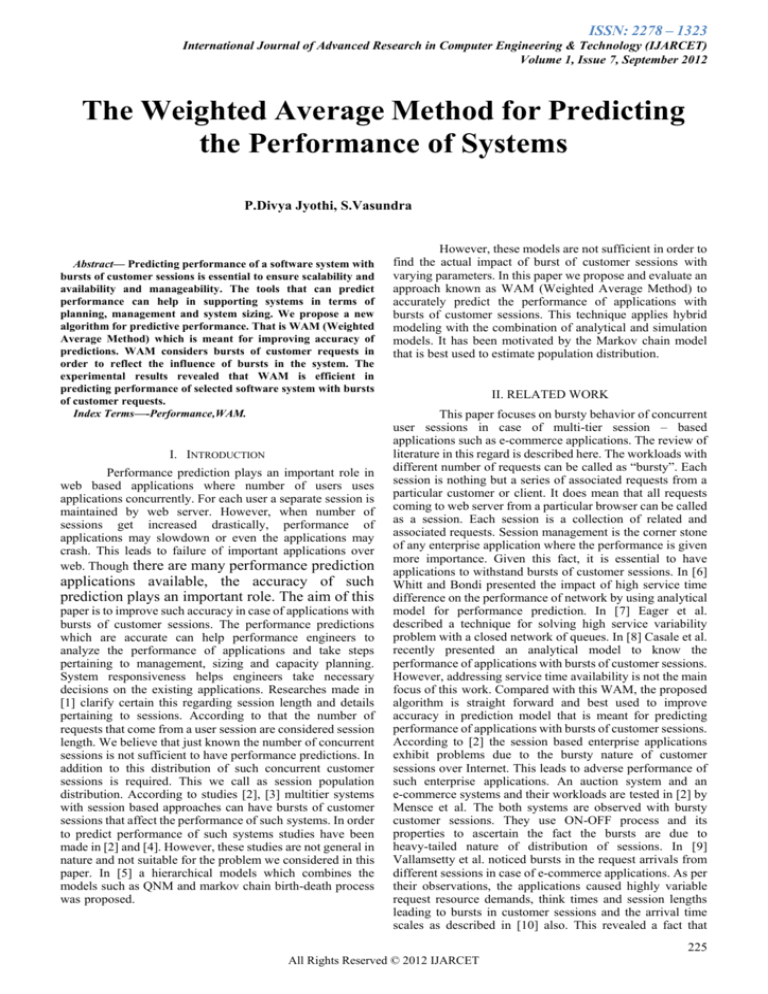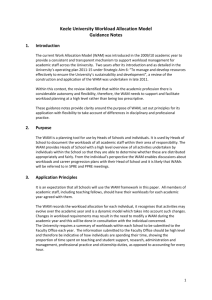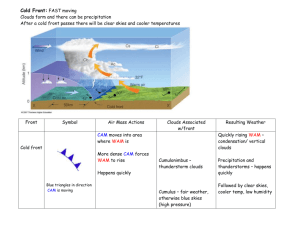
ISSN: 2278 – 1323
International Journal of Advanced Research in Computer Engineering & Technology (IJARCET)
Volume 1, Issue 7, September 2012
The Weighted Average Method for Predicting
the Performance of Systems
P.Divya Jyothi, S.Vasundra
Abstract— Predicting performance of a software system with
bursts of customer sessions is essential to ensure scalability and
availability and manageability. The tools that can predict
performance can help in supporting systems in terms of
planning, management and system sizing. We propose a new
algorithm for predictive performance. That is WAM (Weighted
Average Method) which is meant for improving accuracy of
predictions. WAM considers bursts of customer requests in
order to reflect the influence of bursts in the system. The
experimental results revealed that WAM is efficient in
predicting performance of selected software system with bursts
of customer requests.
Index Terms—-Performance,WAM.
I. INTRODUCTION
Performance prediction plays an important role in
web based applications where number of users uses
applications concurrently. For each user a separate session is
maintained by web server. However, when number of
sessions get increased drastically, performance of
applications may slowdown or even the applications may
crash. This leads to failure of important applications over
web. Though there are many performance prediction
applications available, the accuracy of such
prediction plays an important role. The aim of this
paper is to improve such accuracy in case of applications with
bursts of customer sessions. The performance predictions
which are accurate can help performance engineers to
analyze the performance of applications and take steps
pertaining to management, sizing and capacity planning.
System responsiveness helps engineers take necessary
decisions on the existing applications. Researches made in
[1] clarify certain this regarding session length and details
pertaining to sessions. According to that the number of
requests that come from a user session are considered session
length. We believe that just known the number of concurrent
sessions is not sufficient to have performance predictions. In
addition to this distribution of such concurrent customer
sessions is required. This we call as session population
distribution. According to studies [2], [3] multitier systems
with session based approaches can have bursts of customer
sessions that affect the performance of such systems. In order
to predict performance of such systems studies have been
made in [2] and [4]. However, these studies are not general in
nature and not suitable for the problem we considered in this
paper. In [5] a hierarchical models which combines the
models such as QNM and markov chain birth-death process
was proposed.
However, these models are not sufficient in order to
find the actual impact of burst of customer sessions with
varying parameters. In this paper we propose and evaluate an
approach known as WAM (Weighted Average Method) to
accurately predict the performance of applications with
bursts of customer sessions. This technique applies hybrid
modeling with the combination of analytical and simulation
models. It has been motivated by the Markov chain model
that is best used to estimate population distribution.
II. RELATED WORK
This paper focuses on bursty behavior of concurrent
user sessions in case of multi-tier session – based
applications such as e-commerce applications. The review of
literature in this regard is described here. The workloads with
different number of requests can be called as “bursty”. Each
session is nothing but a series of associated requests from a
particular customer or client. It does mean that all requests
coming to web server from a particular browser can be called
as a session. Each session is a collection of related and
associated requests. Session management is the corner stone
of any enterprise application where the performance is given
more importance. Given this fact, it is essential to have
applications to withstand bursts of customer sessions. In [6]
Whitt and Bondi presented the impact of high service time
difference on the performance of network by using analytical
model for performance prediction. In [7] Eager et al.
described a technique for solving high service variability
problem with a closed network of queues. In [8] Casale et al.
recently presented an analytical model to know the
performance of applications with bursts of customer sessions.
However, addressing service time availability is not the main
focus of this work. Compared with this WAM, the proposed
algorithm is straight forward and best used to improve
accuracy in prediction model that is meant for predicting
performance of applications with bursts of customer sessions.
According to [2] the session based enterprise applications
exhibit problems due to the bursty nature of customer
sessions over Internet. This leads to adverse performance of
such enterprise applications. An auction system and an
e-commerce systems and their workloads are tested in [2] by
Mensce et al. The both systems are observed with bursty
customer sessions. They use ON-OFF process and its
properties to ascertain the fact the bursts are due to
heavy-tailed nature of distribution of sessions. In [9]
Vallamsetty et al. noticed bursts in the request arrivals from
different sessions in case of e-commerce applications. As per
their observations, the applications caused highly variable
request resource demands, think times and session lengths
leading to bursts in customer sessions and the arrival time
scales as described in [10] also. This revealed a fact that
225
All Rights Reserved © 2012 IJARCET
ISSN: 2278 – 1323
International Journal of Advanced Research in Computer Engineering & Technology (IJARCET)
Volume 1, Issue 7, September 2012
modeling customer behavior in terms of bursts of customer
sessions can improve the chances of accurate prediction of
performance of applications with bursts of customer sessions.
The bursty nature of customer sessions can have major
impact on applications as they are subjected to unpredictable
workloads over a period of time. This may results in those
applications to fail in fair processing of requests coming from
customers across the globe. In [11] Crovella and Lipsky
made experiments on bursty systems and came to know that
heavy-tailed distributions of customer requests resulted in
different measures for each and every run.
In [10] the bursty nature of multi-tier session based
systems has been confirmed. With workloads taken from
benchmark TPC-W, they found that many similar runs of
measurements with similar resource demands and expected
throughput resulted in different mean response time
measurements. This is evident that raises a fact indicating the
modeling approaches are to be changed to meet the actual
requirements. Many predictive performance models have
come into existence. However better modeling approaches
came into existence known as QNM with Mean Value
Analysis and Markove Chains. Some approximation
techniques [8] and [12] also came into existence.
Due to the problems in the existing predictive
performance models, we propose a model known as WAM
(Weighted Average Method) which considers the not only
number of concurrent sessions but distributions of session
population in order to accurately measure the performance of
multi-timer, session – based applications with bursts of
customer sessions. The following section describes WAM
algorithm.
Fig. 1 – WAM algorithm
III. WAM
The Weighted Average Method (WAM) algorithm
helps in improving accuracy of predicting performance of
applications with bursts of customer sessions. Especially this
kind algorithm is useful to web based applications such as
e-Commerce, enterprises. This is because the web
applications can be used by multiple users concurrently. Thus
concurrent user sessions are possible. This is the suitable
environment in which WAM can be applied. The WAM
parameters and the procedure are given in fig. 1 in the form
an algorithm.
As provided in fig. 1, the WAM algorithm starts
with some event list known as FEL (Future Event List). This
vector contains a set of request objects. Each request object
contains request start time, end time and a Boolean flag
indicating whether the request is the last request in a session.
These request objects are loaded from historical trace table.
Then it initializes all parameters required including aggregate
state time array, aggregate state completions array and other
variables like state start time, state end time etc. Statement 9
is the while loop that is responsible to iterate through all
request of FEL. Finally it computes think time and creates
request submission event besides updating FEL. Finally line
13 computes Rmean values and they are sent to table. From
table they are picked and presented in the form of a graph as
shown in fig. 3.
IV.EXPERIMENTS
This section describes the experiments and the
results including the environment used for the sake of
experiments.
Environment
The environment used for experiments include Java
6.0, NetBeans IDE, Oracle 10G Express Edition running in a
PC with Windows 7 Operating System. NetBeans IDE is
used for rapid application development while Oracle
database is used to store historical trace and also results of
experiments.
Experiment Design
Experiment design includes a GUI application that
facilitates the demonstration of WAM algorithm that is meant
for predicting the performance of an application with bursts
of client requests. Java’s Swing API is used to build graphical
user interface while JDBC API is used to interact with
backend. WAM algorithm is implemented using core Java
logic based on [22].
Methodology
The methodology used to implement WAM and
perform experiments with bursts of customer sessions is
All Rights Reserved © 2012 IJARCET
226
ISSN: 2278 – 1323
International Journal of Advanced Research in Computer Engineering & Technology (IJARCET)
Volume 1, Issue 7, September 2012
described here. First of all a historical trace is obtained and
stored in Oracle database. Therefore the historical trace is
considered as dataset for the experiments. The actual
experiments are performed using a prototype application
with GUI. The operations performed through GUI are
generating historical trace, deleting historical trace, viewing
historical trace, initializing FEL, building FEL from
historical trace, predicting performance and generating graph
automatically. The results are saved in database and the graph
picks values from table to show the results of WAM
algorithm.
Prototype Application
The frontend application built to demonstrate the
WAM algorithm for predicting performance of an
application with bursts of customer sessions provides
user-friendly interface that facilitates all operations. Fig. 1
shows the main UI screen.
on the number of sessions and requests of each session as
input given by the user. This option facilitates end users to
have an idea of the trace before conducting actual
experiments with WAM algorithm. The “Initialize FEL”
button is meant for initializing Future Event List. Once FEL
is initialized it is possible to populate FEL with actual events
provided in the form of historical trace. The “Create FEL
from Historical Trace” button is responsible to take records
from historical trace file and load each record into a POJO
(Plain Old Java Object) object and then has a java.util.List
object containing a collection records that constitute FEL. By
now the historical trace with all events are readily available in
FEL. This is the time to apply WAM algorithm shown in Fig.
1 on FEL. The “Predict Performance” button is meant for
actually performing the proposed algorithm on FEL and
provides results. This kind of experiments is made number of
times and the results are recorded.
V. RESULTS
As can be seen in fig. 3, the CDF (Cumulative Distribution
Function) varies for different replications. The summary of
all experiments are presented in the graph. In X axis
replications are presented while the Y axis shows response
time.
Fig. 2 – Main Screen with WAM related operations
As can be seen in fig. 2, the operations supported by
the frontend application include clearing historical trace,
generating historical trace, viewing historical trace,
initializing FEL, creating FEL from historical trace,
predicting performance of given application based on the
dataset (historical trace). Then options are given for showing
graph and terminating the frontend application. On choosing
“Clear Historical Trace” button, it automatically deletes all
records in the historical trace table. This is required to
experiment the application with different number of bursts of
customer sessions. The “Generate Historical Trace” button is
meant for taking number of sessions and number of requests
per session as input from user and generates records into
historical trace table. These records in the table are
considered to be dataset for the experiments.
This operation facilitates to have multiple trace
related to various applications and apply WAM algorithm to
predict performance of the application with bursts of
customer sessions. These records are later loaded into RAM
for further processing.
The “View Historical Trace” button is meant for
viewing historical trace that is automatically generated based
Fig. 3 – Measured Rmean values for given dataset
The replication 4 shows longest response time while
the replication 3 shows shortest response time. The highest
Rmean value and lowest Rmean value are exhibited by CDFs of
replication four and three respectively. These results from
WAM algorithm can help application performance analysts
to estimate the application performance with bursts of
customer sessions. They can easily predict the problems and
provide solutions with ease by repeatedly running various
applications with different session traces. This is the
significance of WAM algorithm explored with a prototype
application in this paper.
VI. CONCLUSION
In this paper, we present and explore an algorithm
by name Weighted Average Method (WAM) for enhancing
the accuracy in predicting the performance of applications
with bursts of customer sessions. For all session based
systems especially web applications including e-commerce
227
All Rights Reserved © 2012 IJARCET
ISSN: 2278 – 1323
International Journal of Advanced Research in Computer Engineering & Technology (IJARCET)
Volume 1, Issue 7, September 2012
and distributed enterprise applications the proposed
technique can be applied and the performance analysts can
make decisions based on the predictive performance of
application done using WAM. WAM allows experiments to
be made with real world traces of customer sessions and also
the traces synthesized. We developed a prototype application
with GUI to demonstrate the effectiveness of WAM. We
generated session traces for the sake of experiments. We also
tested the application with various traces and the summary of
values is presented. The experimental results revealed that
the WAM algorithm is able to give accurate results and this is
useful in predicting performance of real world applications
with bursts of customer sessions.
REFERENCES
[1] T. Bonald and J.W. Roberts, “Congestion at Flow Level and
the Impact of User Behaviour,” Computer Networks, vol. 42,
Conditions in Simulations with Heavy-Tailed Workloads,”
Proc. 29th Conf. Winter Simulation, pp. 1005-1012, 1997.
[12] Y. Chen, S. Iyer, X. Liu, D. Milojicic, and A. Sahai, “SLA
Decomposition: Translating Service Level Objectives to
System Level Thresholds,” Proc. Fourth Int’l Conf.
Autonomic Computing, 2007.
P.Divyajyothi M.Tech Student, CSE Department, JNTUACEA,
Anantapur, Andhra Pradesh, India.
S.VasundaraM.Tech,(Ph.D.),Associate Professor, CSE Department,
JNTUACEA, Anantapur, Andhra Pradesh, India.
pp. 521- 536, 2003.
[2] D. Menasce, V. Almeida, R. Reidi, F. Pelegrinelli, R. Fonesca,
and W. Meira JR, “In Search of Invariants in e-Business
Workloads,” Proc. ACM Conf. Electronic Commerce, pp. 5665, Oct. 2000.
[3] U. Vallamsetty, K. Kant, and P. Mohapatra, “Characterization
of e-Commerce Traffic,” Electronic Commerce Research, vol.
3, nos. 1/2, pp. 167-192, 2003.
[4] K. Psounis, P. Molinero-Ferna´ndez, B. Prabhakar, and F.
Papadopoulos, “Systems with Multiple Servers under HeavyTailed Workloads,” Performance Evaluation, vol. 62, nos. 1-4,
pp. 456- 474, Oct. 2005.
[5] D. Menasce and V. Almeida, Capacity Planning and
Performance Modeling: From Mainframes to Client-Server
Systems. Prentice Hall, 1994.
[6] A.B. Bondi and W. Whitt, “The Influence of Service-Time
Variability in a Closed Network of Queues,” Performance
Evaluation, vol. 6, no. 3, pp. 219-234, Sept. 1986.
[7] D.L. Eager, D.J. Sorin, and M.K. Vernon, “AMVA
Techniques for High Service Time Variability,” Proc. ACM
SIGMETRICS Int’l Conf. Measurement and Modeling of
Computer Systems, pp. 217-228, 2000.
[8] G. Casale, N. Mi, and E. Smirni, “Bound Analysis of Closed
Queuing Networks with Workload Burstiness,” Proc. ACM
SIGMETRICS Int’l Conf. Measurement and Modeling of
Computer Systems, pp. 13-24, 2008.
[9] U. Vallamsetty, K. Kant, and P. Mohapatra, “Characterization
of e-Commerce Traffic,” Electronic Commerce Research, vol.
3, nos. 1/2, pp. 167-192, 2003
[10] D. Krishnamurthy, J. Rolia, and S. Majumdar, “A Synthetic
Workload Generation Technique for Stress Testing SessionBased Systems,” IEEE Trans. Software Eng., vol. 32, no. 11,
pp. 868-882, Nov. 2006.
[11] M.E. Crovella and L. Lipsky, “Long-Lasting Transient
All Rights Reserved © 2012 IJARCET
228








